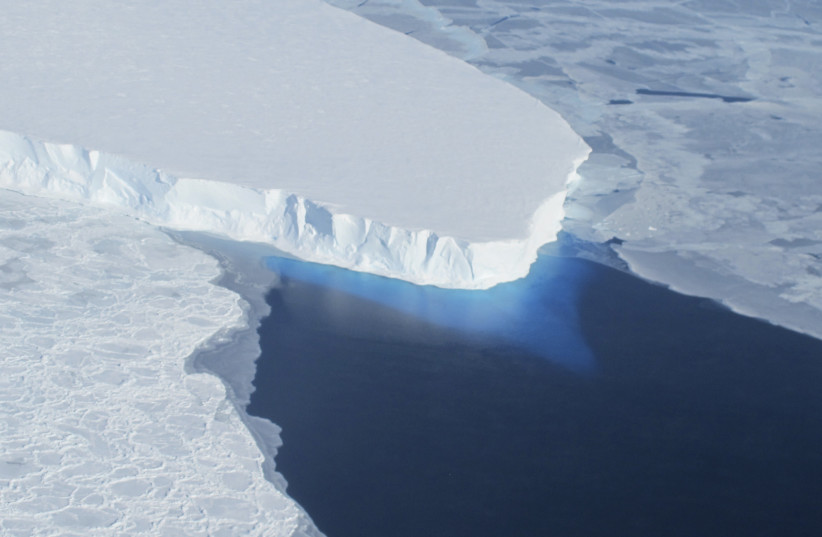Scientists at the University of East Anglia in the United Kingdom identified a process that contributed to the melting of Antarctic glaciers.
The researchers, led by Dr. Tiago Dotto from the Centre for Ocean and Atmospheric Sciences at the University of East Anglia, published their findings in a peer-reviewed study in the journal Nature Communications on Wednesday.
In the study, the researchers found that ice shelves that are adjacent to one another contribute to instability in other ice shelves downstream.
Furthermore, the researchers found that an ocean gyre, a system of circulating currents adjacent to the Thwaites Ice Shelf, can impact the amount of meltwater flowing under the shelf. When the gyre becomes weakened, increasing amounts of warm water can reach the area beneath the ice shelf, causing it to thaw.
One of the largest ice shelves in West Antarctica, the Thwaites Ice Shelf is part of the Thwaites Glacier, which the University of East Anglia noted has been melting quickly over the past two decades and is the greatest contributor to global sea-level rise of all the glaciers on the continent.

“We have identified another process that could impact the stability of ice shelves, revealing the importance of local ocean circulation and sea ice”
Dr. Tiago Dotto, Centre for Ocean and Atmospheric Sciences, University of East Anglia
The researchers used data collected from sensors installed under the ice shelf and found that the ocean water beneath the shelf became significantly warmer between January 2020 and March 2021.
“Here we use in situ oceanographic observations to show that the TEIS [Thwaites Ice Shelf] cavity warmed between January 2020 and March 2021, and simultaneously the glacial-meltwater content increased in the upper layers,” the researchers said.
Warm water melting Thwaites Ice Shelf's base
The greatest contributor to the warming was water flowing from the Pine Island Ice Shelf, located east of the Thwaites Ice Shelf, containing glacial meltwater.
The meltwater combines with saltwater when the base of ice shelves is melted by the ocean and it can form a layer of buoyant, warm water that melts the base of the Thwaites Ice Shelf.
“We have identified another process that could impact the stability of ice shelves, revealing the importance of local ocean circulation and sea ice,” said Dotto.
“Circumpolar Deep Water, a warm variety of Antarctic waters, is a key player in melting the base of ice shelves. However, in this study, we show that a great amount of heat at shallow layers beneath one ice shelf can be provided by waters originating from other melting ice shelves nearby.
“Therefore, what happens to one ice shelf, can impact the adjacent ice shelf, and so on.
This process is important for regions of high ice shelf melting such as the Amundsen Sea because one ice shelf sits next to the other, and the export of heat from one ice shelf can reach the next one through the ocean circulation.”
“Recent observations and ocean simulations suggest that the eastern side of TEIS [Thwaites Ice Shelf] is fed by mCDW [modified Circumpolar Deep Water] that has previously circulated near Pine Island Bay (PIB),” the study noted. “An autonomous-underwater-vehicle survey below the ice-shelf front near the western side of TEIS also showed the presence of mCDW from PIB at 800–1000 m depth, indicating that there is a deep connection below TEIS through which deep warm water flows westward.”
In January 2020, researchers drilled holes in the ice and inserted temperature, current and salinity-measuring sensors under the Thwaites Ice Shelf. Based on a year's worth of observations, the researchers hypothesized that the heat that was causing the shelf to melt could not have come from the Thwaites Ice Shelf as strong melting was not detected by the sensors at the areas in which they were installed.
Using this data in conjunction with computer simulations, the researchers found that water from the Pine Island Ice Shelf is able to reach beneath Thwaites Ice Shelf.
The researchers identified the way this process occurs by using simulations generated by computer models, as well as data collected from tags that were attached to seals. They found that a gyre located near the Thwaites Ice Shelf becomes weakened during the winter, enabling more heat to flow to the areas under the shelf.
Additionally, satellite images revealed an unusually high concentration of ice near the Thwaites Ice Shelf during throughout the summers of 2020 and 2021.
Based on their findings and the computer models, the researchers suggested that the gyre was even weaker, causing excess meltwater from adjacent ice shelves to enter the Thwaites Ice Shelf as they could not be moved to another area by the ocean currents.
Finally, the researchers noted that "a change in the gyre direction could warm the ice-shelf cavities even faster ... because it could lift the isopycnals [layers] further up beneath the ice shelf and bring deeper warm waters upwards."
